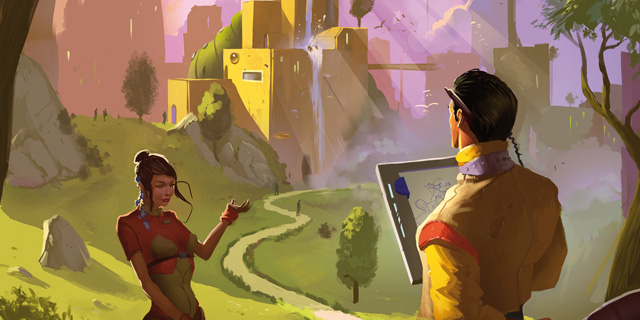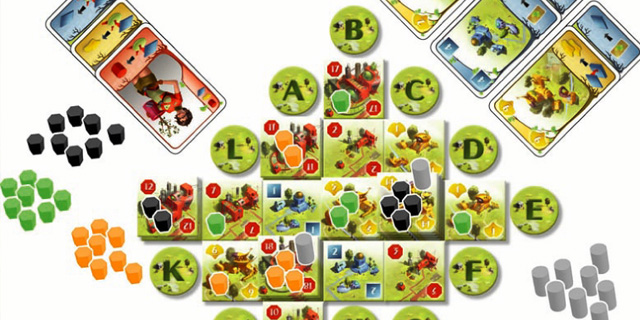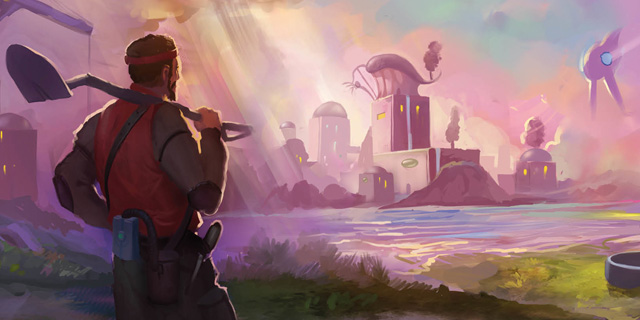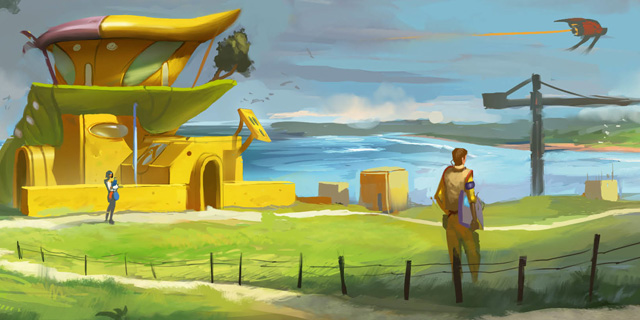
Thus far the offerings of designer Xavier Georges have been somewhat mixed in my eyes. I appreciated the Wild West development of Carson City, but it was a little too much work for the amount of entertainment I got from it. Troyes, on the other hand, came up with some interesting dice-worker mechanics but got bogged down by too many options. His latest Z-Man published title, Ginkgopolis, is much more streamlined and as a result faster-playing, but will it stand up to repeated plays where his others have fallen flat?
So far, my answer is yes. Ignoring the bizarre sci-fi theme centered around the Gingko Biloba tree being a symbol of harmonious growth with nature, Gingkopolis combines several established mechanics into a cohesive whole. Each player begins with three character cards (selected from preset groups in the beginner game, drafted in an experienced game) that indicate a starting amount of resources, success points, and building tiles as well as providing benefits when playing cards and tiles. The tiles represent buildings and come in three colors that represent their respective production. Red tiles produce resources, blue tiles produce more tiles and yellow tiles produce points. Each tile has a corresponding card, as do the twelve urbanization areas (A through L) surrounding the initial 3-by-3 array of tiles. Four cards are dealt to each player, which along with their stock of tiles and resources will determine what actions are available.

Each card can be played either alone or with a tile. A card played alone is “exploited” and generates either the appropriate product of the indicated building (equal to the level of the building) or the player’s choice of a resource or a tile (in the case of an urbanization card) before being discarded. An urbanization card played with a tile places the tile on the respective urbanization area (which then moves to the player’s choice of the edges of the new tile). That tile then receives a resource from the player, (and a “new building” marker from the stock) all adjacent tiles produce as if they were exploited, and then the urbanization card is discarded. Playing a building card with a tile allows the player to build the new tile on top of the old one. Any existing resources on the old tile are returned to their player, who is awarded one point per resource if it is not the current player, and the new tile receives resources from the current player equal to its level (plus a “new building” marker). No products are generated by the build action, but the building card played is added to the player’s character cards to provide future powers or end game bonus points.
Any powers a player’s character and building cards provide trigger when the appropriate action is taken, which is what makes the game really work. Exploiting a card for, say, a single tile might not seem like an attractive play, but when your available powers trigger to give you two resources and a point or two that seems much more efficient. You will need at least two resources and a tile to build and thus gain more powers, so maneuvering yourself into that situation is definitely in your best interest for the long run. Of course, building can be tricky. If your new tile is a different color than the one you are covering, it will cost you an additional resource (returned to your unavailable supply). If the number of the new tile is lower than the one you are covering, you must pay the difference in accumulated success points; of course, the highest-numbered buildings are often worth the most end-game bonus points, so as long as the difference isn’t too great that is probably a sacrifice you will be willing to make.

Greatly helping the speed of play is the fact that choosing what card or tile to play each turn is done simultaneously, then executed in player order. Once everyone has completed their action, the remaining three cards in each player’s hand are passed to the left (along with the start player card) and each player then receives a new card. When the draw deck is exhausted, any cards corresponding to new buildings placed are added to the discards (and the “new building” markers removed from them) and then the discards are reshuffled. When the available supply of tiles is exhausted for the first time, players may simultaneously select some of their accumulated tiles to be returned to the stock for one point apiece. When the tiles are exhausted a second time, or if one player manages to place all of their resources on the city (even if they are later returned via a later player building on top of them), the game ends.
In addition to points provided by the powers of high-level building cards, points are also scored for resources in the city. Each connected district of more than one like-colored tile is scored for majority; the player with the majority scores points equal to the total number of resources in that district, while the second-place player scores equal to the number of resources (s)he has there. Ties are broken by highest-level building, and then by highest-numbered building. Finally, each player begins the game with two “new hand” tokens that can be discarded at any point to discard their current hand and draw four new cards but are worth two points each if still in a player’s possession at the end of the game.

It can be difficult to go into a game of Ginkgopolis with a predetermined strategy, as both the cards and tiles you receive at any given point are random and will greatly affect your options. Adaptation and flexibility will serve you well. Acquiring several powers will also be to your benefit, as while specialization can be rewarded by some endgame scoring, it might be difficult to get there if you have few ways to generate resources or tiles. You will also want to keep an eye on the districts as they develop, as the scoring provided there can drastically swing a game. Of course, if you never have the right cards or tiles to disrupt — or enhance! — them, then you might just have to sit by and watch the game slip away. That is never a good feeling, and one of the few strikes I can find against Ginkgopolis, but hardly game-breaking. Some analysis paralysis can creep in, especially if a player has a large number of tiles in their possession, as each tile represents four additional options each turn and that can quickly become overwhelming. On the whole, though, the simultaneous play really helps to move things along.
Ginkgopolis plays in an hour or less and supports up to five players. Solitaire rules are also included, but I haven’t bothered to explore them. There’s a lot of wood and cardboard in this box, and as such it retails for around $60.



















